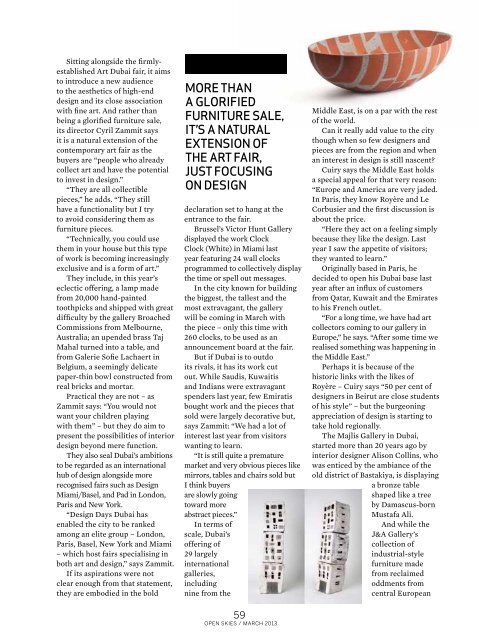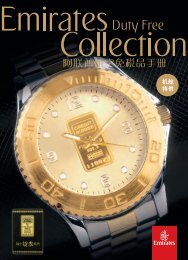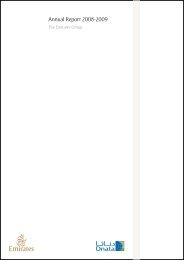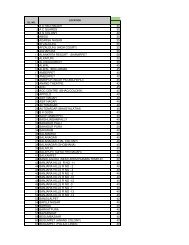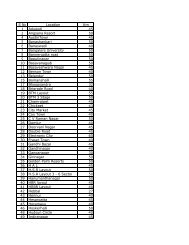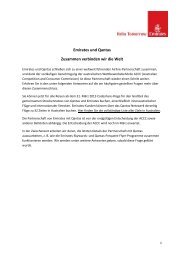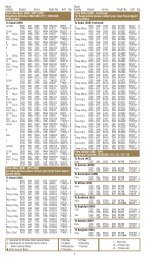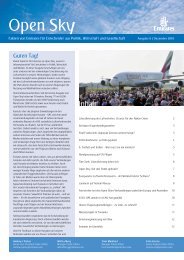Hans-Sachs-Straße - Emirates.com
Hans-Sachs-Straße - Emirates.com
Hans-Sachs-Straße - Emirates.com
You also want an ePaper? Increase the reach of your titles
YUMPU automatically turns print PDFs into web optimized ePapers that Google loves.
Sitting alongside the firmlyestablished<br />
Art Dubai fair, it aims<br />
to introduce a new audience<br />
to the aesthetics of high-end<br />
design and its close association<br />
with fine art. And rather than<br />
being a glorified furniture sale,<br />
its director Cyril Zammit says<br />
it is a natural extension of the<br />
contemporary art fair as the<br />
buyers are “people who already<br />
collect art and have the potential<br />
to invest in design.”<br />
“They are all collectible<br />
pieces,” he adds. “They still<br />
have a functionality but I try<br />
to avoid considering them as<br />
furniture pieces.<br />
“Technically, you could use<br />
them in your house but this type<br />
of work is be<strong>com</strong>ing increasingly<br />
exclusive and is a form of art.”<br />
They include, in this year’s<br />
eclectic offering, a lamp made<br />
from 20,000 hand-painted<br />
toothpicks and shipped with great<br />
difficulty by the gallery Broached<br />
Commissions from Melbourne,<br />
Australia; an upended brass Taj<br />
Mahal turned into a table, and<br />
from Galerie Sofie Lachaert in<br />
Belgium, a seemingly delicate<br />
paper-thin bowl constructed from<br />
real bricks and mortar.<br />
Practical they are not – as<br />
Zammit says: “You would not<br />
want your children playing<br />
with them” – but they do aim to<br />
present the possibilities of interior<br />
design beyond mere function.<br />
They also seal Dubai’s ambitions<br />
to be regarded as an international<br />
hub of design alongside more<br />
recognised fairs such as Design<br />
Miami/Basel, and Pad in London,<br />
Paris and New York.<br />
“Design Days Dubai has<br />
enabled the city to be ranked<br />
among an elite group – London,<br />
Paris, Basel, New York and Miami<br />
– which host fairs specialising in<br />
both art and design,” says Zammit.<br />
If its aspirations were not<br />
clear enough from that statement,<br />
they are embodied in the bold<br />
More than<br />
a glorified<br />
furniture sale,<br />
it’s a natural<br />
extension of<br />
the art fair,<br />
just focusing<br />
on design<br />
declaration set to hang at the<br />
entrance to the fair.<br />
Brussel’s Victor Hunt Gallery<br />
displayed the work Clock<br />
Clock (White) in Miami last<br />
year featuring 24 wall clocks<br />
programmed to collectively display<br />
the time or spell out messages.<br />
In the city known for building<br />
the biggest, the tallest and the<br />
most extravagant, the gallery<br />
will be <strong>com</strong>ing in March with<br />
the piece – only this time with<br />
260 clocks, to be used as an<br />
announcement board at the fair.<br />
But if Dubai is to outdo<br />
its rivals, it has its work cut<br />
out. While Saudis, Kuwaitis<br />
and Indians were extravagant<br />
spenders last year, few Emiratis<br />
bought work and the pieces that<br />
sold were largely decorative but,<br />
says Zammit: “We had a lot of<br />
interest last year from visitors<br />
wanting to learn.<br />
“It is still quite a premature<br />
market and very obvious pieces like<br />
mirrors, tables and chairs sold but<br />
I think buyers<br />
are slowly going<br />
toward more<br />
abstract pieces.”<br />
In terms of<br />
scale, Dubai’s<br />
offering of<br />
29 largely<br />
international<br />
galleries,<br />
including<br />
nine from the<br />
59<br />
Open skies / march 2013<br />
Middle East, is on a par with the rest<br />
of the world.<br />
Can it really add value to the city<br />
though when so few designers and<br />
pieces are from the region and when<br />
an interest in design is still nascent?<br />
Cuiry says the Middle East holds<br />
a special appeal for that very reason:<br />
“Europe and America are very jaded.<br />
In Paris, they know Royère and Le<br />
Corbusier and the first discussion is<br />
about the price.<br />
“Here they act on a feeling simply<br />
because they like the design. Last<br />
year I saw the appetite of visitors;<br />
they wanted to learn.”<br />
Originally based in Paris, he<br />
decided to open his Dubai base last<br />
year after an influx of customers<br />
from Qatar, Kuwait and the <strong>Emirates</strong><br />
to his French outlet.<br />
“For a long time, we have had art<br />
collectors <strong>com</strong>ing to our gallery in<br />
Europe,” he says. “After some time we<br />
realised something was happening in<br />
the Middle East.”<br />
Perhaps it is because of the<br />
historic links with the likes of<br />
Royère – Cuiry says “50 per cent of<br />
designers in Beirut are close students<br />
of his style” – but the burgeoning<br />
appreciation of design is starting to<br />
take hold regionally.<br />
The Majlis Gallery in Dubai,<br />
started more than 20 years ago by<br />
interior designer Alison Collins, who<br />
was enticed by the ambiance of the<br />
old district of Bastakiya, is displaying<br />
a bronze table<br />
shaped like a tree<br />
by Damascus-born<br />
Mustafa Ali.<br />
And while the<br />
J&A Gallery’s<br />
collection of<br />
industrial-style<br />
furniture made<br />
from reclaimed<br />
oddments from<br />
central European


